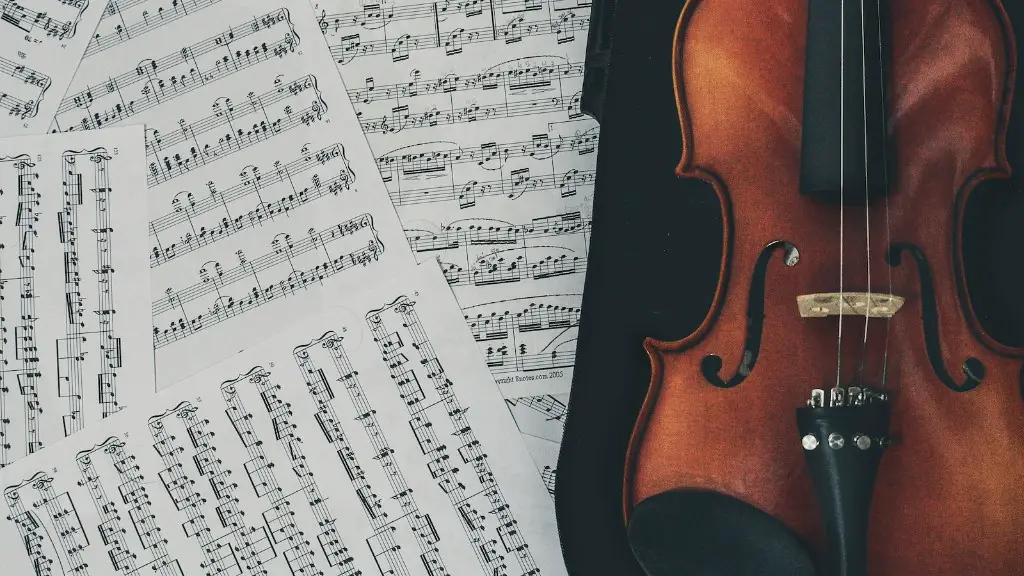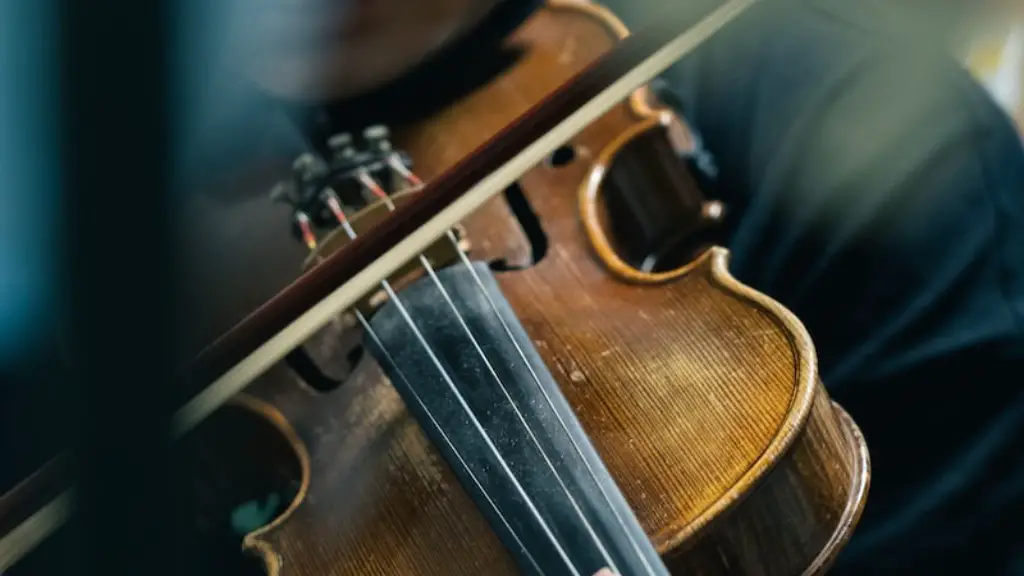Learning how to play the violin is an exciting journey. Knowing how to find notes on a violin can be one of the most important steps in learning how to play. Finding notes on a violin requires a combination of practice, ear training, and knowledge of the instrument. Violin notes are not marked like they are on other stringed instruments, so it is important to understand the layout of the fingerboard and the pitches associated with each note.
In order to find notes on a violin, you will need to learn how to identify intervals and chords by sound. Ear training is essential for recognizing notes by sound alone. You should also become familiar with the parts of a violin and its fingerboard. This includes understanding which strings correspond to each note and where those strings are located on the fingerboard.
Practicing scales is a great way to become familiar with the layout of the fingerboard and learn which hand positions you need for different notes. You can also use an electronic tuner or piano keyboard as reference points for finding notes on your violin. Finally, be sure to practice regularly in order to develop your ear for recognizing individual notes and intervals.
Finding Notes on a Violin
Playing the violin involves understanding how to read music, as well as how to use the instrument. One of the most important skills involved in playing the violin is being able to find notes on the instrument. Learning how to do this requires a firm grasp of music theory and some practice.
The first thing to understand is that there are four strings on a violin – E, A, D, and G. Each string will produce a different note when plucked. The notes that can be produced by each string are determined by their tuning. For example, the E string is tuned to an E note and will produce that same note when plucked. The other strings have different notes associated with them depending on their tuning.
Once you know what notes can be produced by each string, you can start locating these notes on the fingerboard of your violin. To do this, you will need to understand where the various pitches are located on the fingerboard as well as how they correspond to musical notation. This involves learning about musical intervals such as whole steps and half steps and understanding how they relate to scales such as major scales or minor scales.
Once you have figured out where all of these pitches lie on your fingerboard, you can then start finding specific notes by using your fingers or a bow. To do this, you will need to place your fingers in specific positions in order to play certain pitches or combinations of pitches (chords). You may also need to use vibrato or other techniques in order to achieve certain sounds or effects.
Learning how to find notes on a violin takes time and practice but it is an essential skill for any aspiring musician. With enough time and dedication, anyone can learn this skill through basic music theory and practice with their instrument.
Understanding the Structure of a Violin
The violin is an instrument with a unique structure. It is comprised of four strings, each tuned to a different note. The strings are tuned in fifths, meaning that the first string is an ‘A’ and the second string is a ‘D’, while the third and fourth strings are ‘G’ and ‘C’, respectively. The strings are tightly stretched across a bridge and connected to the tailpiece. The neck of the violin is made up of several pieces of wood that form an arch, which supports the fingerboard and frets. The fingerboard has raised ridges called frets, which create distinct notes when pressed down by the fingers. By pressing down on different frets, different notes can be produced in order to play music on the violin.
The best way to learn how to find notes on a violin is to learn its tuning system and practice playing scales. Scales are sequences of notes that ascend or descend in pitch. A scale can be played on any string by starting at one fret and following along the fretboard until you reach another fret indicated by your scale. You can then move up or down one fret until you reach another note indicated by your scale pattern. Practicing scales helps players develop their technique and become familiar with how various notes sound when played on the violin.
Playing music on the violin requires mastery of both bowing techniques and fingering techniques. Bowing involves using a bow to draw sound from each string while fingering involves pressing down on certain frets with your left hand fingers in order to create different notes. With practice, it is possible for players to become adept at both techniques and play more complex pieces of music with ease.
In summary, learning how to find notes on a violin requires understanding its structure and practicing scales as well as developing both bowing and fingering
Finding Notes on a Violin
Playing the violin requires an understanding of music notation. Knowing how to read the notes on a staff is essential for playing the instrument. The staff is made up of five lines and four spaces, each representing a different note. The notes on a violin are represented by letter names: A, B, C, D, E, F and G. Each note is assigned a specific position on the staff. For example, A is always placed on the second line from the bottom, while B is always located in the second space from the bottom.
The other notes are arranged in alphabetical order above and below this starting point. When learning to play the violin it’s important to memorize these positions on the staff and associate them with their corresponding letter names. This will make it much easier to read music notation and identify notes quickly when playing. Additionally, there are several techniques for finding notes on a violin such as using open strings and learning musical intervals. With practice you can become proficient at reading music notation and playing with accuracy and ease.
Familiarize Yourself With the Musical Alphabet
Learning the musical alphabet is an important step in learning how to find notes on a violin. The musical alphabet consists of seven letters: A, B, C, D, E, F and G. Each of these letters corresponds to a note on the violin fretboard. By understanding what each letter stands for and how they are arranged on the fretboard, you can quickly locate any note on the instrument.
The musical alphabet repeats itself after G. When you reach G again, you start over with A. This creates a pattern that can be used to quickly identify notes on the violin fretboard. For example, if you know that a particular note is an F# (F sharp), then you know it will be two frets higher than an F note. Similarly, if you were looking for a Bb (B flat) then it would be one fret lower than a B note.
It’s also important to understand that some notes will have two names depending on their position in relation to other notes in the scale. For example, C# and Db are actually the same note but are referred to by different names depending on which scale they occur in. Be sure to practice playing both versions of these dual-named notes so that you can easily recognize them when reading music notation or tablature.
Learning About the Different Octaves on a Violin
The violin is an instrument with four strings tuned in perfect fifths. It also has four distinct octaves, with each string having two octaves of notes. The first two strings (G and D) are the highest in pitch, while the last two (A and E) are the lowest in pitch. Knowing how to identify notes on a violin helps musicians understand how different notes interact with each other.
To identify notes on a violin, it is important to understand that each string is tuned to a specific note, starting with G at the top and ending with E at the bottom. The second string (D) is one fifth lower than G and so on. From there, beginning violists can learn to identify other notes by counting up or down from the known note. For example, counting up one fret along a string will raise it by one half step, while counting down one fret will lower it by one half step.
Knowing how to read music can also help violists learn to recognize different octaves of notes on the instrument. Notes are written in lines and spaces that represent different pitches, with lines typically representing higher pitches and spaces representing lower pitches. Once you understand where each note lies within its line or space, you can then start to recognize when a note is higher or lower than its original tuning.
Finally, it helps for beginners to practice playing scales so that they can familiarize themselves with how each note changes when moving up or down an octave. Scales consist of successive notes that ascend or descend in order of pitch. Practicing scales will help you develop an ear for recognizing different octaves of notes on your violin and help you become more confident when reading music notation as well as playing melodies by ear.
Finding Notes on a Violin
Learning to identify notes on a violin can be a challenging but rewarding skill. It is important to understand the basics of musical notation and the layout of the violin, including its strings and the fretboard. Once you have an understanding of these concepts, you can begin to learn how to recognize notes by sight or ear.
When trying to identify notes by sight, look for patterns in the music that indicate the note’s name. For example, a half-note followed by two quarter-notes will usually be an E note on the violin. Memorizing these patterns can help you become more familiar with locating notes on the instrument. Additionally, learning how to read sheet music can help you find notes quickly and accurately.
Identifying notes by ear requires practice as well as an understanding of musical intervals. If you have already learned some basic scales and melodies on the violin, you may be able to recognize certain intervals that indicate specific notes. Listen for changes in pitch and use your knowledge of music theory to determine which note is being played.
In order to become proficient at finding notes on a violin, it is important to practice regularly. With enough time and dedication, you will be able to recognize notes quickly and accurately by both sight and ear.
Final Words
In conclusion, the correct size of a violin depends on the player’s body size and arm length. To determine the right size, measure the distance from your neck to your wrist and compare it to the violin’s measurement chart. It is important to use a tape measurer and not a ruler, as rulers can provide inaccurate measurements. Make sure to also take into account other factors such as playing style, experience level, and personal preference. With these tips in mind, you will have no problem finding the best violin size for you!





